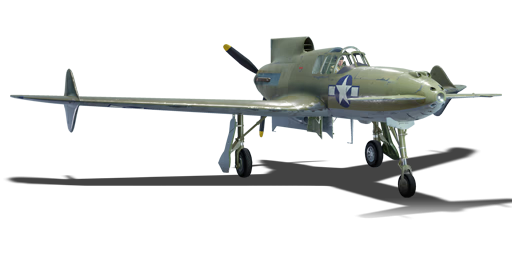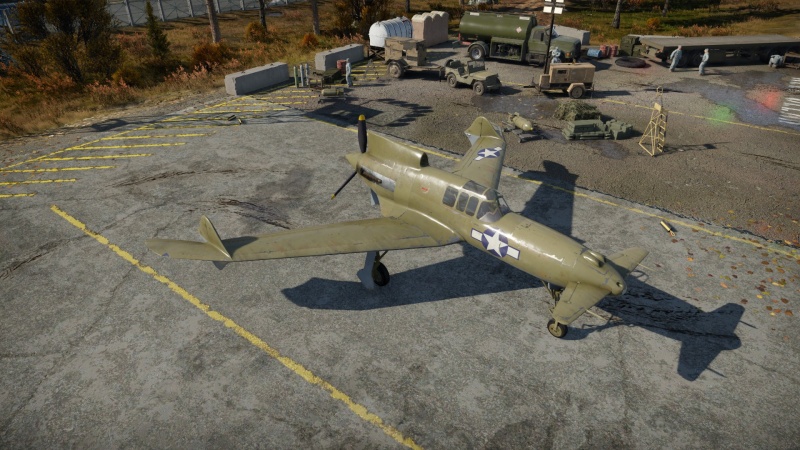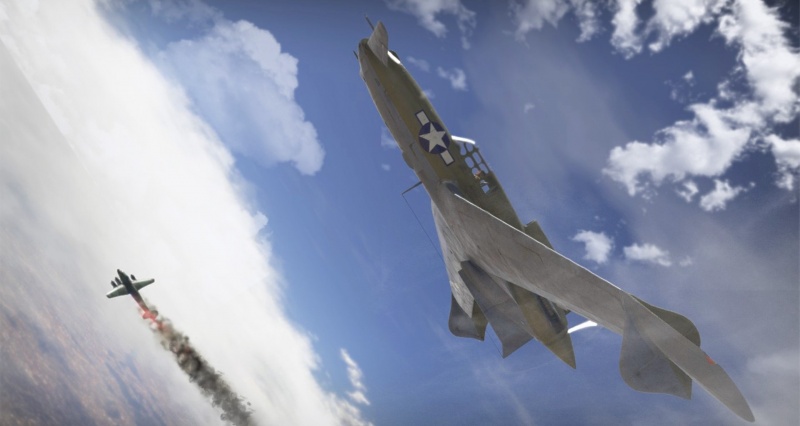XP-55
Contents
Description
Researching new designs for better fighter and interceptor performances, the United States encouraged companies to develop radical new designs away from conventional fighter aircraft. Among the different designs submitted, Curtis-Wright's CW-24B design won out and their aircraft became designated as the XP-55 Ascender. With its front horizontal stabilizer (canard) contributing significantly to lift, it effectively acts as part of the wing, allowing the main wing area to be reduced, and also reducing the aircraft's drag. Three prototypes were created, but the flight characteristics were deemed not sufficient enough upgrade compared to conventional designs, and incoming jet age caused the US to refocus priority into new jet designs, leading to the cancellation of the XP-55.
Introduced in Update 1.31, the XP-55 Ascender is unlike anything most players would see in the U.S. tech tree. Flying this aircraft effectively requires a dedication to Energy Fighting. The XP-55 excels significantly in the ability to climb and dive, and this is your most significant advantage. The Ascender has decent manoeuvrability and best used in a Boom & Zoom function. All four of this aircraft's armament are packed tightly in the nose for devastating results.
General info
Flight performance
The XP-55's level speed is decent compared to other planes at a similar tier, climb rate is quite good, although the acceleration is mediocre. Turn rate at very low speed is not satisfying, but it gets better once the plane reaches higher speed (~400 km/h) and once it gets there it turns very well, even near the structural limit speed which is very high. Stalling characteristics is very different compared to other planes, especially during the flight after reducing the power, it tends to stall without dropping on one wing and with no lean to any side, it can be very dangerous during the landing on the airfield at low speed.
The engine can start overheating after a few minutes flying on War Emergency Power, especially on hot maps and when the player is using automatic engine controls, but it cools down fast once the power is reduced or after switching to manual engine controls and open the radiator. Also, when the XP-55 reaches a higher and colder altitude (above 4,000 m), the plane is noticeably faster to accelerate and the engine is less prone to overheating.
Perhaps the most distinctive characteristic of the XP-55 is its impressive energy retention. The plane has earned the nickname "the UFO" from the community due to its ability to dive into an enemy at an insane speed and quickly climb back to high altitude (up to 2,000 m) as well as remaining highly agile. This allows the XP-55 to tackle any target provided that it has an altitude advantage and pull off from them untouched.
| Characteristics | Max Speed (km/h at 5,000 m) |
Max altitude (metres) |
Turn time (seconds) |
Rate of climb (metres/second) |
Take-off run (metres) | |||
|---|---|---|---|---|---|---|---|---|
| AB | RB | AB | RB | AB | RB | |||
| Stock | 605 | 589 | 10500 | 30.0 | 30.8 | 15.3 | 15.3 | 232 |
| Upgraded | 652 | 628 | 28.8 | 29.2 | 22.9 | 18.6 | ||
Details
| Features | ||||
|---|---|---|---|---|
| Combat flaps | Take-off flaps | Landing flaps | Air brakes | Arrestor gear |
| ✓ | ✓ | ✓ | X | X |
| Limits | ||||||
|---|---|---|---|---|---|---|
| Wings (km/h) | Gear (km/h) | Flaps (km/h) | Max Static G | |||
| Combat | Take-off | Landing | + | - | ||
| 900 | 350 | 523 | 488 | 310 | ~10 | ~6 |
| Optimal velocities (km/h) | |||
|---|---|---|---|
| Ailerons | Rudder | Elevators | Radiator |
| < 463 | < 460 | < 520 | > 315 |
| Compressor (RB/SB) | ||
|---|---|---|
| Setting 1 | ||
| Optimal altitude | 100% Engine power | WEP Engine power |
| 4,724 m | 1,125 hp | 1,277 hp |
Survivability and armour
- 9.5 mm Steel - Armour plate behind the control panel
- 9.5 mm Steel - Armour plate behind pilot's headrest
- 40 mm Bulletproof glass - Windshield
While not a fully developed fighter aircraft, the XP-55 prototype initially only sported a 9.5 mm steel plate behind the pilot's headrest. Without any other protection, the XP-55 was susceptible to machine gun and cannon fire from all directions. While the headrest armour and the engine protected the pilot from the rear, there were not many stopping bullets from the front, sides, bottom, or top. Taking this fighter in a head-on with another aircraft is a mixed bag as the XP-55 has the perfect weapon configuration for it. However, the pilot is in an extremely vulnerable to inbound bullets. The aircraft's manoeuvrability can enable it to get some shots off and then manoeuvre out of the way.
When attacking an XP-55, the rear end of the aircraft is the best place to target, as that is where the engine is and is extremely exposed from behind. If you can manage to hit the wing-tips, you can take out one of the two rudders throwing off the balance of the aircraft, causing it to spin out of control. Of course, without much armour protection, the pilot can be a target of choice as even small calibre machine gun fire can be enough to take him out. If needed, try to get the XP-55 to bleed its speed or get into a turn-fight where it will be more difficult for them to manoeuvre out of the way or take back the advantage.
Modifications and economy
Armaments
Offensive armament
The XP-55 is armed with:
- 2 x 20 mm AN/M2 cannons, nose-mounted (200 rpg = 400 total)
- 2 x 12.7 mm M2 Browning machine guns, nose-mounted (200 rpg = 400 total)
Although the unconventional XP-55 has its engine and propeller installed at the rear of the aircraft, one bonus of this is that it leaves the entire nose section free to install guns and their associated ammunition. This is precisely what the Curtiss-Wright engineers did by mounting two 20 mm cannons and two 12.7 mm M2 machine guns. While provisions were made for an additional two guns, they were never added. The XP-55 pilot will need to be satisfied with the four guns which are installed and should have no problem wreaking havoc with them.
All four guns are centre-mounted, which eliminates the need to calculate for convergence, and while the punching power of the bullets drops off after a while, there should be no issues when firing as close as 100 m or as far as +800 m if you are sniping aircraft. Even though the 12.7 mm and 20 mm rounds have slightly different velocities, it should not affect landing the lead on the target in the gun sight.
Usage in battles
Against fighters
Quite high climb speed allows the plane to gets high fast after the start of the battle, which makes possible at what this plane excels: boom & zoom capability. It can dive at really high speed and easily get back to the previous altitude. Its armament that is located in the nose of the plane, high pitch and yaw responsiveness makes head-on encounters not so hard, but the plane can be set on fire very easily when the player is not cautious. Overall, it can deal with encounters at a similar altitude and in most situations, only one attack and a few hits will be needed to destroy the enemy plane. The small profile of wings makes it harder to hit, which the player can used during evasive manoeuvres. The plane itself can also take some damage and still fly.
Its high level speed allows it to get away from most of the Japanese fighters, but it should not be overestimated since the XP-55's acceleration is not great. Japanese planes like the J2M series are fast and can catch the Ascender at low altitude, and they can also easily outclimb it.
Compared to German planes it is not so fast, a player needs to be prepared for facing them at similar or higher altitude, their Bf 109 series have better climb rate, and the Fw 190 series is as fast, although with worse climb rate. The latter family of German fighters should be avoided in head-on situation, because of their exceptionally powerful armament.
Against Italian fighters, similar tactics should be used to that one against the Japanese fighters: their planes are slower, with similar climb rate but an exceptionally good offensive armament.
Bomber hunting
While the XP-55 features mediocre protection for the pilot, it can be used as a bomber hunter to great effect. There are two main tactics for the XP-55 for bomber hunting:
- Boom-and-zoom: start by climbing to an optimal altitude (above 4000 m), target any bomber below you in your proximity: dive and unleash hell upon them, then pull up back into altitude. Usually, a single pass is enough to destroy or cripple the enemy bomber, though you can perform a second pass in case they survived.
- Tailing: occasionally, you may have to engage enemy bombers without altitude advantage. You can approach them from a paralell flight path and target their engines, tail, or wings, all while performing weaving manoeuvres to avoid defensive fire from rear gunners. Against most bombers, the XP-55's airframe and armour are enough to withstand a fair amount of rounds that many of the front-engine fighters cannot as the engine is located in the rear and thus spared from defensive fire, allowing it to pursue them.
Manual Engine Control
| MEC elements | ||||||
|---|---|---|---|---|---|---|
| Mixer | Pitch | Radiator | Supercharger | Turbocharger | ||
| Oil | Water | Type | ||||
| Controllable | Controllable Auto control available |
Not controllable Not auto controlled |
Controllable Auto control available |
Separate | Not controllable 1 gear |
Not controllable |
Pros and cons
Pros:
- Good high-speed manoeuvrability
- Excellent climb rate
- Insanely high dive speed, can reach Mach 0.75
- Insane acceleration in a dive
- Centre-lined, nose-mounted armament, cluster fire without the need for convergence
- Engine performance increase at higher altitude (4000 m)
- Outstanding energy retention in level flight, after a dive
- Fantastic Boom & Zoom fighter
Cons:
- Cannot snap-roll at all unless you want a stall spin
- Roll rate is somewhat lacking compared to most contemporaries
- Will abruptly and heavily compress when diving at a speed higher than Mach 0.75
- Mediocre protection for pilot, head-ons are not advised
- Engine in the rear of aircraft, susceptible to gunfire if being chased
- Fighter only, no options for suspended ordnance
History
The U.S. Army sponsored three prototypes for a new pusher power-plant propelled fighter in 1941. Out of this was born the Vultee XP-54, Northrop XP-56 Black Bullet, and the Curtiss-Wright XP-55 Ascender. Four airframes were built for testing the Ascender. The first aircraft was delivered on July 13, 1943. During its testing, they discovered it required a long take-off run for the nose-mounted elevator to become effective. Before the issue could be addressed, the aircraft was lost on November 15th. The second and third XP-55 flew in the spring of 1944. The second aircraft was used as a testbed for armament.
On May 27, 1945, the third XP-55 took flight for public display over a crowd of 100,000 people. When the XP-55 crossed the airfield, the pilot began to roll the aircraft. Without warning, the plane dove straight into the ground while being inverted. The pilot was thrown from the wreckage and suffered severe injuries. A nearby bystander was killed. After testing, the Ascender was judged to have poor performance and handling. The design was ultimately deemed too ineffective for a fighter. Although the XP-55 program was plagued with issues, it made numerous contributions to aircraft design. The second XP-55 is still on display today at the Smithsonian Institute's National Air and Space Museum in Washington D.C.
| Archive of the in-game description | |
|---|---|
|
Curtiss-Wright XP-55 Ascender single-engine army interceptor fighter prototype The Curtiss-Wright XP-55 (company designation CW-24) prototype interceptor fighter was developed to meet the requirements of Proposal R-40C, issued by the United States Army Air Corps on November 27, 1939. It called for the creation of a fighter outperforming all existing models in speed, rate of climb, manoeuvrability, armament, and pilot visibility. In addition, it required that the new fighter would have small production and maintenance costs. The R-40C requirements specifically mentioned that the aircraft to be created should have an unconventional aerodynamic configuration. The aircraft created by the Curtiss-Wright designers had a canard configuration with swept wings and a pusher propeller. The swept wings had ailerons and flaps, and small fins with rudders were fitted at the wing tips. The horizontal empennage was under the wings. The CW-24 had a tricycle landing gear with a nosewheel. The Curtiss Company also proposed using the new, yet untested Pratt & Whitney X-1800 liquid-cooled engine, mounted behind the pilot and driving the pusher propeller. On 10 July 1942, the US Army Air Corps ordered three prototype aircraft, which received the army designation of ХР-55. Since there was much difficulty with the further development of the Pratt & Whitney X-1800 engine, the company's specialists decided to use an Allison V-1710-95 twelve-cylinder, V-type, liquid-cooled engine, which produced a takeoff power of 1,275 hp. The aircraft's armament consisted of four 12.7 mm Colt-Browning AN-M2.5 machine guns with 200 rounds each. Two 20 mm Bendix-Hispano AN-M2C cannons, with 200 rounds each, were planned to be mounted on this series, as well. The ХР-55 prototype (Ser No. 42-78845) performed its first flight on July 19, 1943, at Scott Field Air Force Base, not far from the Curtiss-Wright factory in St. Louis. The tests showed that the ХР-55 had satisfactory controllability when flying horizontally or gaining altitude, but the pilots experienced some inconveniences when landing or flying at low speeds, as they could not feel any load on the elevator. There were also some cooling problems with the Allison V-1710-95 engine, which was located in the rear section of the airframe. The ХР-55's characteristics were not particularly outstanding, and even inferior to those of fighters of classic conventional configuration already in service. Besides, it became quite evident by early 1944 that further fighter development would employ not piston but turbojet engines. As a result, no order for full-scale production followed, and all work on the ХР-55 was discontinued. | |
Media
- Skins
- Videos
See also
- Aircraft with similar configuration
External links
Paste links to sources and external resources, such as:
- topic on the official game forum;
- other literature.
| Curtiss-Wright Corporation | |
|---|---|
| Fighters | BF2C-1 |
| P-36A · Rasmussen's P-36A · P-36C · P-36G | |
| P-40C · P-40E-1 · P-40F-10 | |
| Bombers | SB2C-1C · SB2C-4 |
| Floatplanes | SOC-1 |
| Experimental | XP-55 |
| Export | H-75A-1 · H-75A-4 · H-81A-2 · ▂P-40E-1 · ␗P-40E-1 · ▄P-40F-5 Lafayette · CW-21 · Hawk III |
| ▄SB2C-5 | |
| Captured | ▀Hawk H-75A-2 |
| USA fighters | |
|---|---|
| P-26 Peashooter | P-26A-33 · P-26A-34 · P-26A-34 M2 · P-26B-35 |
| P-36 Hawk | P-36A · Rasmussen's P-36A · P-36C · ○P-36C · P-36G |
| P-39 Airacobra | P-400 · P-39N-0 · P-39Q-5 |
| P-40 | P-40C · P-40E-1 · P-40E-1 TD · P-40F-10 |
| P-43 Lancer | P-43A-1 |
| P-47 Thunderbolt | P-47D-22-RE · P-47D-25 · P-47D-28 · P-47M-1-RE · ⋠P-47M-1-RE · P-47N-15 |
| P-51 Mustang | P-51 · P-51A (Thunder League) · P-51C-10 · P-51D-5 · P-51D-10 · P-51D-20-NA · P-51D-30 · P-51H-5-NA |
| P-63 Kingcobra | P-63A-5 · P-63A-10 · P-63C-5 · ␠Kingcobra |
| Prototypes | XP-55 |
| F2A Buffalo | F2A-1 · Thach's F2A-1 · F2A-3 |
| BF2C | BF2C-1 |
| F3F | F3F-2 · Galer's F3F-2 |
| F4F Wildcat | F4F-3 · F4F-4 |
| F4U Corsair | F4U-1A · F4U-1A (USMC) · F4U-1D · F4U-1C · F4U-4 · F4U-4B · F4U-4B VMF-214 · F2G-1 |
| F6F Hellcat | F6F-5 · F6F-5N |
| F8F Bearcat | F8F-1 · F8F-1B |
| Other countries | ▃Ki-43-II · ▃Ki-61-Ib · ▃A6M2 · ▃Bf 109 F-4 · ▃Fw 190 A-8 · ▃Spitfire LF Mk IXc |
| USA premium aircraft | |
|---|---|
| Fighters | Thach's F2A-1 · Galer's F3F-2 · F2G-1 · F4U-4B VMF-214 · P-26A-34 · P-40C · P-43A-1 |
| P-47M-1-RE · ⋠P-47M-1-RE · P-51A · P-51D-10 · P-51D-20-NA · ␠Kingcobra · XP-55 | |
| ▃A6M2 · ▃Ki-43-II · ▃Ki-61-Ib · ▃Bf 109 F-4 · ▃Fw 190 A-8 · ▃Spitfire LF Mk IXc | |
| Twin-engine fighters | XP-38G · Bong's P-38J-15 · P-38K · YP-38 · P-61A-11 · XF5F · XP-50 · F7F-3 |
| Jet fighters | P-59A · F-86F-35 · F-89B · F-89D · F-4S Phantom II · F-5C · F-20A |
| Strike aircraft | A-1H · A2D-1 · AU-1 · XA-38 · AV-8A · A-6E TRAM · A-10A |
| Bombers | A-26C-45DT · B-10B · BTD-1 · PBM-3 "Mariner" · PV-2D |






